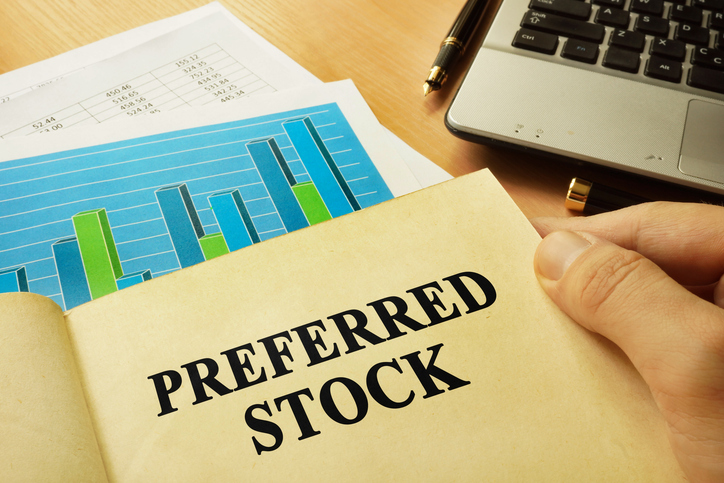When people talk about investing in stocks, they usually mean common stock — the type that gives shareholders voting rights and potential for long-term growth. However, there’s another important category of stock that many investors overlook called preferred stock. Preferred stock is a hybrid between stocks and bonds, offering investors a unique blend of benefits. Like common stock, it represents ownership in a company, but it also comes with fixed-income features similar to bonds.
A financial advisor can help you manage your portfolio and choose the right investments, including stocks, for your situation.
Common vs. Preferred Stock
Most people will need to invest in the stock market if they’re going to save enough for retirement. But not all stock is created equal. When you buy common stock, your dividends can vary. One big difference between common and preferred stock? Preferred stock generally comes with a fixed dividend rate.
Dividends to preferred shareholders are paid before dividends to common shareholders. Another difference is that if the company that issued the shares is liquidated, preferred stockholders will have access to the company’s assets before common stockholders. Owners of preferred stock are behind bondholders in line for company assets, but they’re ahead of owners of common stock. Sounds good, right?
But there’s a catch. With preferred stock, because you’re pretty much locking in your rate of return at the time of purchase, you won’t gain from company growth (in the form of higher dividends) as a common stockholder would. Your dividends could be deferred if the company can’t afford to pay shareholders.
Plus, you don’t have voting rights as a preferred shareholder the way you would if you owned common stock. The good news is that the dividends from your preferred shares will receive the same favorable tax treatment that regular dividends receive.
Callable Preferred Stock

Many preferred shares are “callable.” Callable preferred stock is a type of preferred stock that gives the issuing company the right, but not the obligation, to repurchase shares at a predetermined price after a specified date.
This means that after a certain period, the company can “call” back the stock from investors, usually at a price slightly above its original issue price, known as the call price. Like other preferred stocks, callable preferred stock pays regular, fixed dividends, making it an attractive option for income-focused investors. However, it comes with the risk that the company may redeem the shares earlier than anticipated.
Preferred Stock vs. Bonds
Torn between the potential returns of stock and and the predictability of bonds? You may be drawn to preferred stock. That’s because preferred stock combines traits of both stocks and bonds. You’ll get paid at a fairly fixed rate (as with bonds), but that rate will be higher than the rates on Treasury bonds (as with stocks).
A word of caution: bonds have one serious advantage over preferred stocks that’s worth mentioning. As with dividends on common stock, dividends on preferred stock aren’t guaranteed. A company may stop paying dividends if it falls on tough times. This can’t happen with a bond because a bond represents a contractual obligation between the company and the bondholder. So, if you need fixed income that’s fixed, you’re probably better off with bonds than with preferred stock.
Non-callable bonds have another advantage over callable preferred stock, which is that the owner isn’t subject to a “call” from the issuer. If you want to keep a non-callable bond until maturity or until you deem it’s time to sell, you have the right to do so.
Risks of Preferred Stock
Preferred stock isn’t without its risks that need to be considered. For one thing, if interest rates rise, the value of preferred stock falls, just as with bonds. That’s because the opportunity cost of holding that preferred stock is higher once interest rates rise.
Another potential risk that comes with preferred stock is overexposure to certain industries. That’s why some investors choose to buy preferred stock funds, which buy preferred shares from companies across several industries. However, even preferred stock exchange-traded funds (ETFs) may be heavily invested in financial sector companies, since issuing preferred stock is most common in that industry. That means less diversification and more risk.
Preferred stock can be a relatively expensive investment. Because the returns are a) higher than with bonds and b) fixed, fund managers charge more for the privilege of investing in “preferreds.” Investors in preferred stock also bear significant credit risk. The companies that issue preferred stock often do so for reasons that make them risky investments.
Dividends from preferred stock aren’t tax-deductible for the issuer, so the strongest companies with the best credit usually don’t issue preferred stock. Companies that do issue preferreds may do so because they’ve already taken on a lot of debt but still need to raise money. They may call those stocks when the company’s credit rating improves, leaving the investor high and dry.
Bottom Line

Preferred stocks come with several appealing benefits, including steady dividend payments, potential tax advantages, and generally higher yields compared to common stocks and bonds. They can be an excellent choice for income-focused investors seeking a balance between risk and reward. However, before investing, it’s essential to research and compare brokerages to find those offering low fees and favorable trading conditions, ensuring that more of your returns go toward building your wealth rather than covering unnecessary costs.
Tips for Investing
- A financial advisor can help you manage your investments or give you opportunities to find the right assets for your portfolio. Finding a financial advisor doesn’t have to be hard. SmartAsset’s free tool matches you with vetted financial advisors who serve your area, and you can have a free introductory call with your advisor matches to decide which one you feel is right for you. If you’re ready to find an advisor who can help you achieve your financial goals, get started now.
- Consider using an investment calculator to help you understand how your assets could grow over time.
Photo credit: ©iStock/Nikada, ©iStock.com/designer491, ©iStock.com/shapecharge
